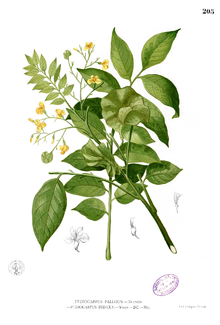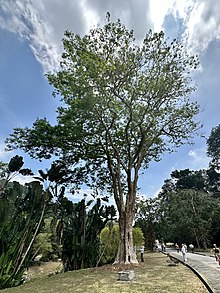
Pterocarpus is a pantropical genus of trees in the family Fabaceae. It belongs to the subfamily Faboideae, and was recently assigned to the informal monophyletic Pterocarpus clade within the Dalbergieae. Most species of Pterocarpus yield valuable timber traded as padauk, usually pronounced or ; other common names are mukwa or narra. The west African species may be traded as African rosewood. P. santalinus also yields the most precious red sandalwood in China known as Zitan. The wood from the narra tree and the Burmese padauk tree is marketed as amboyna when it has grown in the burl form. The scientific name is Latinized Ancient Greek and means "wing fruit", referring to the unusual shape of the seed pods in this genus.
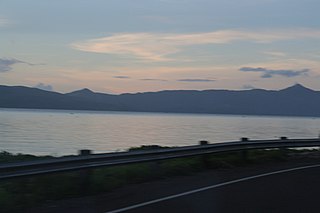
Lake Mainit is the fourth largest lake in the Philippines, having a surface area of 173.40 square kilometres (66.95 sq mi). The lake is also the deepest lake in the country with maximum depth reaching 223 metres (732 ft). It is located in the northeastern section of Mindanao and shared between the provinces of Surigao del Norte and Agusan del Norte.

Narra, officially the Municipality of Narra, is a 1st class municipality in the province of Palawan, Philippines. According to the 2020 census, it has a population of 77,948 people.

Rosewood is any of a number of richly hued hardwoods, often brownish with darker veining, but found in other colours. It is hard, tough, strong, and dense. True rosewoods come from trees of the genus Dalbergia, but other woods are often called rosewood. Rosewood takes a high polish and is used for luxury furniture-making, flooring, musical instruments, and turnery.
Philippine mahogany is a common name for several different species of trees and their wood.

Bloodwood is a common name for several unrelated trees, including:
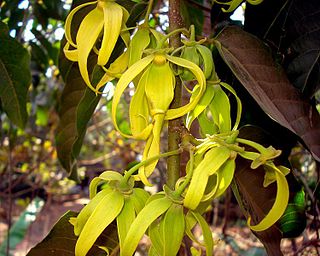
Na ʻĀina Kai Botanical Gardens are nonprofit botanical gardens located at 4101 Wailapa Road, Kīlauea, Kauaʻi, Hawaiʻi. A variety of guided tours are offered Tuesday through Friday; an admission fee is charged for each.

Pterocarpus erinaceus is an endangered species of tree that is native to the Sahelian region of West Africa. It is listed in Appendix II of the Convention on International Trade in Endangered Species of Wild Fauna and Flora. It is used for fuel wood, for medicinal purposes, as a woodworking material, and is useful as a nitrogen-fixing plant to improve nutrient-depleted farming land. It has several common names, including kosso, barwood, African kino tree, muninga, and vène; mukwa is used for this species as well as other Pterocarpus. Groves of the tree can be found on the savannahs of West Africa, but it is becoming increasingly rare and is sometimes cultivated. The tree also grows in forests of Comoé National Park in Côte d'Ivoire, a region geographically close to the Sahel but with a higher moisture regime due to its location between two large rivers. Also, the tree grows in abundance in Kurmi Local Govt. of Taraba State in Nigeria. The tree grows to about 11 meters in height on average, and bears dark, scaly bark and yellow flowers. The fruits are winged pods. P. erinaceus grows well on sunny, hot African plains with long dry seasons and frequent fires.

Pterocarpus macrocarpus, or Burma padauk, is a tree native to the seasonal tropical forests of southeastern Asia: in Myanmar, Laos, Cambodia, Thailand, and Vietnam. It has been naturalized in India and the Caribbean.

Pterocarpus santalinus, with the common names red sanders, red saunders, Yerra Chandanam, Chenchandanam, red sandalwood, Rakta Chandana, and saunderswood, is a species of Pterocarpus endemic to the southern Eastern Ghats mountain range of South India. This tree is valued for the rich red colour of its wood, and in recent years there has been a marked uptick in the use of red sandalwood as a component of incense, especially in the west. The tree is not to be confused with the aromatic Santalum sandalwood trees that grow natively in Southern India.

Pterocarpus dalbergioides, the Andaman padauk, Andaman redwood or East Indian mahogany, is a species of flowering plant in the family Fabaceae. It is sometimes called "narra", but this is just a generic term used for any of several Pterocarpus species. It is native to the Andaman Islands.

Pterocarpus soyauxii, the African padauk or African coralwood, is a species of Pterocarpus in the family Fabaceae, native to central and tropical west Africa, from Nigeria east to Congo-Kinshasa and south to Angola.

Lignum nephriticum is a traditional diuretic that was derived from the wood of two tree species, the narra and the Mexican kidneywood. The wood is capable of turning the color of water it comes in contact with into beautiful opalescent hues that change depending on light and angle, the earliest known record of the phenomenon of fluorescence. Due to this strange property, it became well known in Europe from the 16th to the early 18th century. Cups made from lignum nephriticum were given as gifts to royalty. Water drunk from such cups, as well as imported powders and extracts from lignum nephriticum, were thought to have great medicinal properties.
Coatli is a Nahuatl word meaning "water serpent" or "serpent water" and is the name for several medicinal plants, it can refer to:

The Flora of Malaysia comprises a vast assemblage of plant species estimated to over 15,500 vascular plants. Malaysia boasts 8,019 species of seed plants: 19 species of Gymnosperms and 8,000 Angiosperms. Globally, Malaysia is ranked 14th in terms of species of vascular plants. The Flora of Malaysia consist of approximately 15,000 species of vascular plant. Peninsular Malaysia has around 8,200 species of vascular plants while places such as Sabah and Sarawak has around 12,000 species. Most Flora can be found in the dense rainforest of Malaysia.
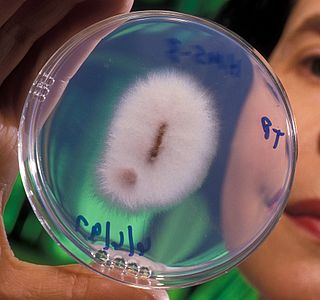
Koa wilt is a relatively new disease to Hawaii, discovered in 1980. Koa wilt is caused by a forma specialis of the fungus Fusarium oxysporum, which is now abundant in Hawaiian soils and infects the native Acacia koa tree, a once-dominant species in the canopy of Hawaiian forests. Fusarium oxysporum f.sp. koae is believed to have been brought into Hawaii on an ornamental acacia plant. Fusarium fungi clog the tree xylem, causing significant wilt and mortality among these beautiful and iconic Hawaiian trees.
Purwodadi Botanical Garden is a research centre in Purwodadi, Pasuruan, East Java, Indonesia. It has an area of 85 hectares and more than 10,000 types of trees and many plant collections. Callus cultures of Agave amaniensis by Setia Dewi were taken in 1988.

The flora of the Philippines boasts a diverse array of plant species given its location in the great Malaysian flora. The Malaysian Phytogeographic zone is considered to be one of the most important centers for plant diversity because of the multitude and variance of species occupying that zone. The archipelago is isolated by a continental and deep ocean.
